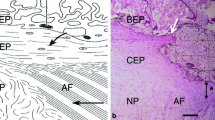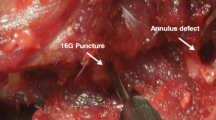Abstract:
In 64 surgically treated herniated lumbar intervertebral discs, we performed histopathological studies of neovascularization in the outermost layer of the herniated mass in various types of hernia. We obtained specimens separately from the capsule tissue covering the herniated mass and the inner tip tissue of the herniated mass for comparison. Histologically, in most cases, the capsule tissue was the outermost layer of the annulus fibrosus or posterior longitudinal ligament, and the inner tip tissue was the nucleus pulposus. In the capsule tissue, newly formed small blood vessels were present in 73.4% of the total cases examined, regardless of the hernia type. However, the frequency and degree of such vessels in the tip tissue were significantly higher in hernias that perforated the posterior longitudinal ligament than in those that did not. When the intervertebral disc herniates, new blood vessels proliferate in the capsule of the hernial tissue. At the stage when the hernial capsule tissue is still present, these vessels were observed to have difficulty reaching the inner tip portion. These findings suggest that when the nucleus pulposus portion of the herniated mass perforates the posterior longitudinal ligament, it may be subject to a stronger neovascularization reaction.
Similar content being viewed by others
Author information
Authors and Affiliations
Additional information
Received for publication on May 18, 1998; accepted on Jan. 19, 1999
About this article
Cite this article
Ozaki, S., Muro, T., Ito, S. et al. Neovascularization of the outermost area of herniated lumbar intervertebral discs. J Orthop Sci 4, 286–292 (1999). https://doi.org/10.1007/s007760050105
Issue Date:
DOI: https://doi.org/10.1007/s007760050105




